|
[1]
|
D. Farnsworth, K. A. Grogan, A. H. C. V. Bruggen, et al., The potential economic cost and response to greening in Florida citrus, Agric. Appl. Econ. Assoc., 29 (2014): 1–6.
|
|
[2]
|
J. M. Bove, Huanglongbing: A destructive, newly-emerging, century-old disease of citrus, J. Plant. Pathol., 88 (2006): 7–37.
|
|
[3]
|
S. Alvarez, D. Solis and M. Thomas, Can Florida's citrus industry be saved while preserving the environment? An economic analysis for the bio-control of the Asian Citrus Psyllid, S. Agric. Econ. Assoc., 2015.
|
|
[4]
|
H. Su, Research and health management of citrus Huanglongbing in Taiwan, In: Proc Intern Research Conference on Huanglongbing, Orlando, Florida, USA, (2008): 57–92.
|
|
[5]
|
A. J. Ayres, J. B. Jr and J. M. Bové, The experience with Huanglongbing management in Brazil, Acta. Hortic., 1065 (2015): 55–62.
|
|
[6]
|
W. Li, Y. N. Yao, L. Wu, et al., Detection and seasonal variations of Huanglongbing disease in navel orange trees using direct lonization mass spectrometry, J. Agric. Food. Chem. , 67 (2019): 2265–2271.
|
|
[7]
|
C. Yang, H. Chen, H. Chen, et al., Antioxidant and anticancer activities of essential oil from Gannan navel orange peel, Molecules, 22 (2017): 1931–1400.
|
|
[8]
|
G. Rao, L. Huang, M. H. Liu, et al., Identification of Huanglongbing-infected navel oranges based on laser-induced breakdown spectroscopy combined with different Chemometric methods, Appl. Optics., 57 (2018): 8738–8742.
|
|
[9]
|
Y. H. Liu and J. H. Tsai, Effects of temperature on biology and life table parameters of the Asian citrus psyllid, Diaphorina Citri Kuwayama (Homoptera: Psyllidae), Ann. Appl. Biol., 137 (2000): 201–206.
|
|
[10]
|
T. H. Hung, S. C. Hung, C. N. Chen, et al., Detection by PCR of Candidatus Liberibacter asiaticus,the bacterium causing citrus huanglongbing in vector psyllids: application to the study of vector pathogen relationships, Plant Pathol., 53 (2004): 96–102.
|
|
[11]
|
F. Wu, Y. J. Cen, X. L. Deng, et al., Movement of Diaphorina citri(Hemiptera: Liviidae) adults between huanglongbing infected and healthy citrus, Flor. Entomol., 98 (2015): 410–416.
|
|
[12]
|
W. Shen, S. E. Halbert, E. Dickstein, et al., Occurrence and ingrove distribution of citrus huang- longbing in north central Florida, J. Plant. Pathol., 95 (2003): 361–371.
|
|
[13]
|
K. L. Manjunath, S. E. Halbert, C. Ramadugu, et al., Detection of Candidatus Liberibacter asiaticus in Diaphorina citri and its importance in the management of citrus huanglongbing in Florida, Phytopathology, 98 (2008): 387–396.
|
|
[14]
|
E. E. G. Cardwell, L. L. Stelinski and P. A. Stansly, Biology and man agement of Asian Citrus Psyllid,vector of the Huanglongbing pathogens, Annu. Rev. Entomol., 58 (2013): 413–432.
|
|
[15]
|
X. Z. Meng and Z. Q. Li, The dynamics of plant disease models with continuous and impulsive cultural control strategies, J. Theor. Biol., 266 (2010): 29–40.
|
|
[16]
|
X. S. Zhang and J. Holt, Mathematical models of cross protection in the epidemiology of plant- virus disease, Anal. Theo. Plant. Pathol., 91 (2001): 924–934.
|
|
[17]
|
S. J. Gao, L. J. Xia, Y. Liu, et al., A plant virus disease model with periodic environment and pulse roguing, Stud. Appl. Math., 136 (2016): 357–381.
|
|
[18]
|
S. Y. Tang, Y. N. Xiao and R. A. Cheke, Dynamical analysis of plant disease models with cultural control strategies and economic thresholds, Math. Comput. Simul., 80 (2010): 894–921.
|
|
[19]
|
M. S. Chan and M. J. Jeger, An analytical model of plant virus disease dynamics with roguing and replanting, J. Appl. Ecol., 31 (1994): 413–427.
|
|
[20]
|
C. Chiyaka, B. H. Singer, S. E. Halbert, et al., Modeling huanglongbing transmission within a citrus tree, PNAS, 109 (2012): 12213–12218.
|
|
[21]
|
R. A. Taylor, E. A. Mordecai, C. A. Gilligan, et al., Mathematical models are a powerful method to understand and control the spread of Huanglongbing, Peer J, 4 (2016): DOI 10.7717/peerj.2642.
|
|
[22]
|
K. Jacobsen, J. Stupiansky and S. S. Pilyugin, Mathematical modeling of citrus groves infected by Huanglongbing, Math. Biosci. Eng, 10 (2013): 705–728.
|
|
[23]
|
R. G. dA. Vilamiu, S. Ternes, G. A. Braga, et al., A model for Huanglongbing spread between citrus plants including delay times and human intervention, AIP. Conf. Proc., 1479 (2012): 2315–2319.
|
|
[24]
|
S. J. Gao, L. Luo, S. X. Yan, et al., Dynamical behavior of a novel impulsive switching model for HLB with seasonal fluctuations, Complexity, 2018 (2018): 1–11.
|
|
[25]
|
J.A. Lee, S. E. Halbert, W. O. Dawson, et al., Asymptomatic spread of Huanglongbing and implications for disease control, Proc. Natl. Acad. Sci. USA., 112 (2015): 7605–7610.
|
|
[26]
|
M. Parry, G. J. Gibson, S. Parnell, et al., Bayesian inference for an emerging arboreal epidemic in the presence of control, Proc. Natl. Acad. Sci. USA., 111 (2014): 6258–6262.
|
|
[27]
|
S. E. Halbert and K. L. Manjunath, Asian citrus psyllids (Sternorrhyncha: Psyllidae) and greening disease of citrus: A literature review and assessment of risk in Florida, Flor. Entomol., 87 (2004): 330–353.
|
|
[28]
|
W. D. Wang and X. Q. Zhao, Threshold dynamics for compartmental epidemic models in periodic environments, J. Dyn. Differ. Equ., 20 (2008): 699–717.
|
|
[29]
|
P. V. D. Driessche and J. Watmough, Reproduction numbers and sub-threshold endemic equilibria for compartmental models of disease transmission, Math. Biosci., 180 (2002): 29–48.
|
|
[30]
|
H. R. Thieme, Convergence results and poincare-bendixson trichotomy for asymptotically au-tonomous differential equations, J. Math. Biol., 30 (1992): 755–763.
|
|
[31]
|
P. V. D. Driessche and J. Watmough, Reproductive numbers and subthreshold endemic equilibria for compartmental models of disease transmission, Math. Biosci., 180 (2002): 29–48.
|
|
[32]
|
D. Xu and X. Q. Zhao, Dynamics in a periodic competitive model with stage structure, J. Math. Anal. Appl., 311 (2005): 417–438.
|
|
[33]
|
X. Zhao, Dynamical Systems in Population Biology, Springer, New York, NY, USA, 2003.
|
|
[34]
|
T. K. Kar and A. Batabyal, Stability analysis and optimal control of an SIR epidemic model with vaccination, Biosystems, 104 (2011): 127–135.
|
|
[35]
|
L. Y. Pang, S. G. Ruan, S. H. Liu, et al. , Transmission dynamics and optimal control of measles epidemics, Appl. Math. Comput., 256 (2015): 131–147.
|
|
[36]
|
M. A. Khan, R. Khan, Y. Khan, et al., A mathematical analysis of Pine Wilt disease with variable population size and optimal control strategies, Chaos, Solitons and Fract., 108 (2018): 205–217.
|
|
[37]
|
W. H. Fleming and R. W. Rishel, Deterministic and Stochastic Optimal Control, Springer-Verlag, New York, Berlin, 1975.
|
|
[38]
|
D. L. Lukes, Differential equations: Classical to Controlled, Mathematics in Science and Engi-neering, Academic Press, New York, 1982.
|
|
[39]
|
S. Lenhart and J. T. Workman, Optimal control applied to biological models, Mathematical and Computational Biology Series, Chapman & Hall/CRC Press, London/Boca Raton, 2007.
|
|
[40]
|
X. Zhang, Y. Zhao and A. Neumann, Partial immunity and vaccination for influenza, J. Comput. Biol., 17 (2009): 1689–1696.
|
|
[41]
|
T. Gottwald, Current epidemiological understanding of citrus Huanglongbing, Annu. Rev. Phy-topathol., 48 (2010): 119–139.
|
|
[42]
|
K. S. P. Stelinski, R. H. Brlansky, T. A. Ebert, et al., Transmission parameters for Candidatus Liberibacter asiaticus by Asian citrus psyllid (Hemiptera: Psyllidae), J. Econ. Entomol., 103 (2010): 1531–1541.
|
|
[43]
|
M. E. Rogers, General pest management considerations, Citrus. Ind., 89 (2008): 12–15.
|










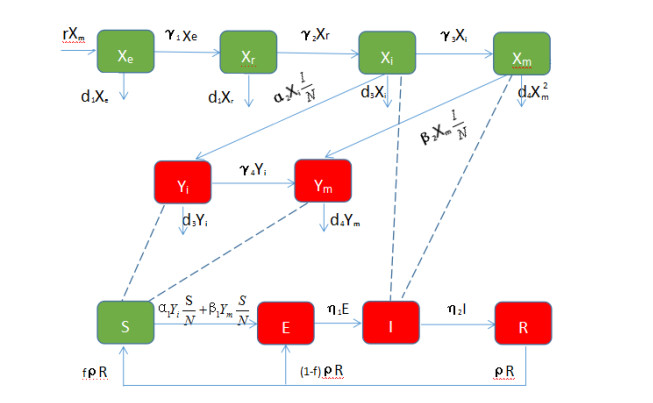
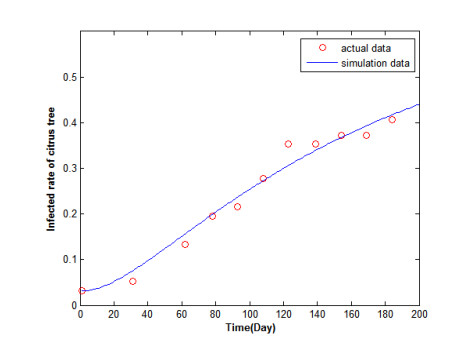
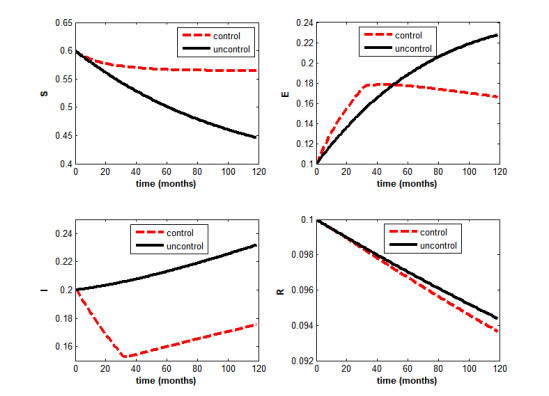
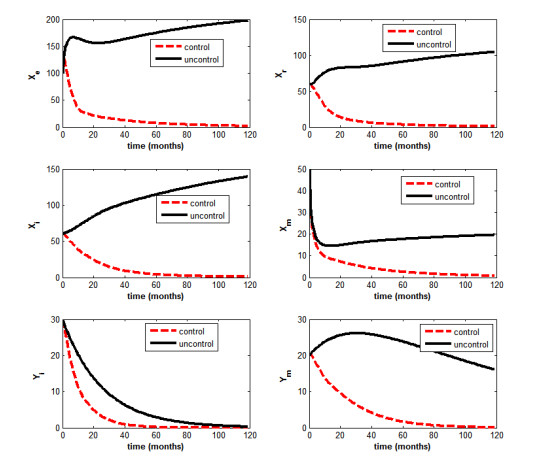
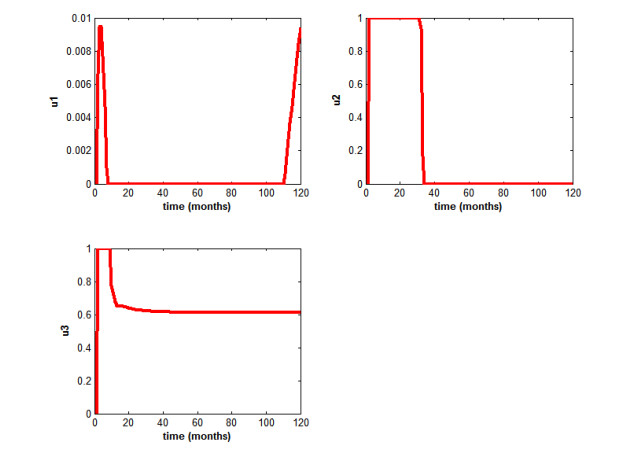


 DownLoad:
DownLoad: